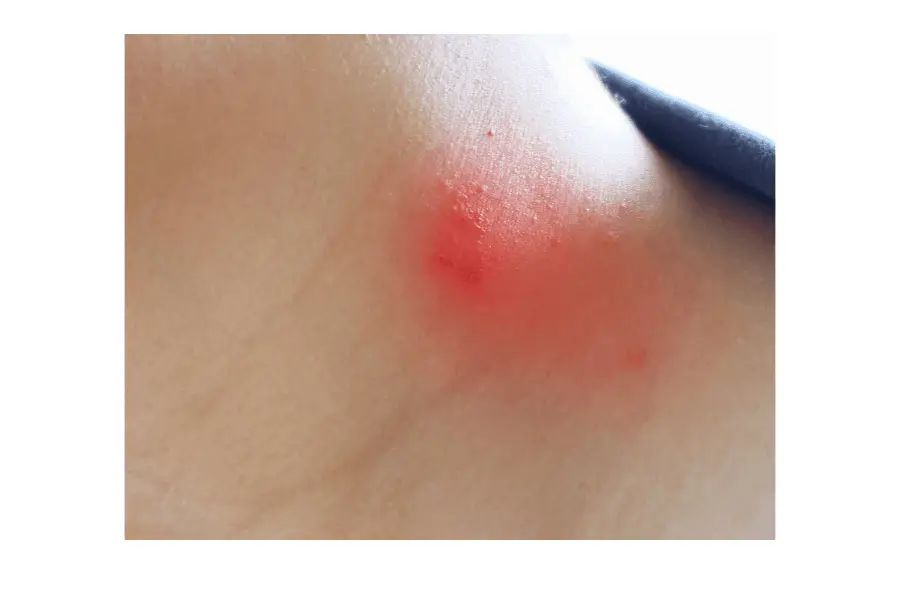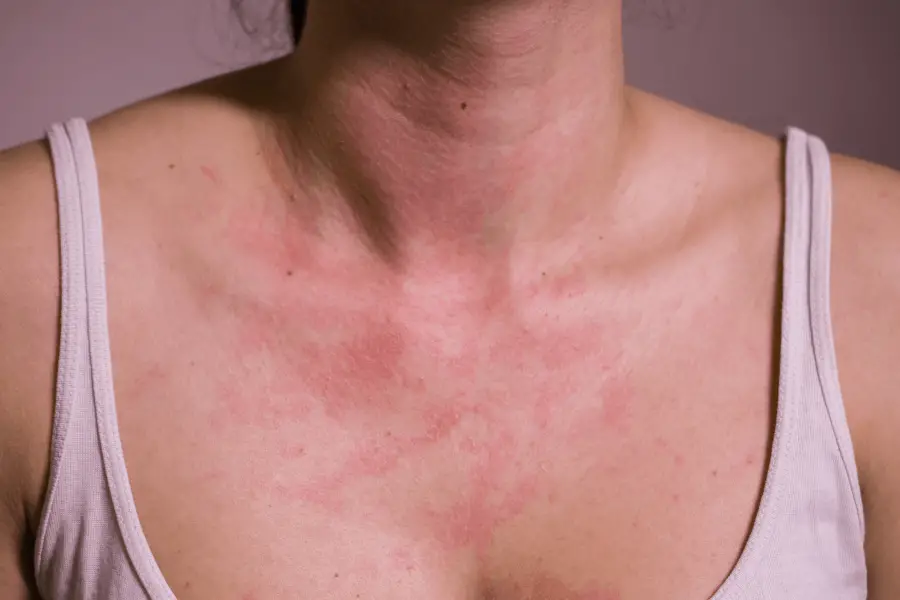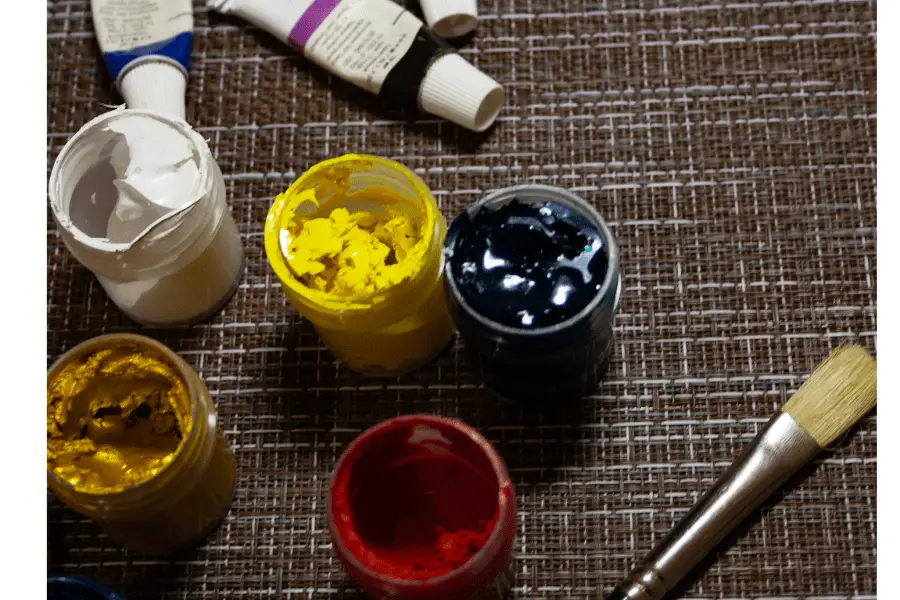Allergies can be really difficult and even scary to deal with, especially if you’re not 100% sure what you are allergic to. It could be animals, certain smells, or even paint chemicals.
If you are a painter and you realize that you are having some allergic reaction symptoms frequently, you might be allergic to something in the paint. So can acrylic paint to cause allergic reactions? Yes, it definitely can. You can be allergic to some of the ingredients in acrylic paint that can cause an allergic reaction.
In this article we go over everything you need to know about allergies to paint, what those symptoms look like, and how to treat a paint allergic reaction. Let’s read on!
Can Acrylic Paint Make You Sick?

In most cases, acrylic paint is not toxic because it is a water based paint. If acrylic paint contains any toxic chemicals, they will be clearly marked on the label of the paint. In another one of my articles, I talk about acrylic paint being toxic.
However, if there are toxic ingredients in the paint, they usually only become toxic if they are used to airbrush, if they are sanded down, or if large amounts are ingested.
Arylics are typically safe to use as long as you are using them for painting purposes. It is not likely that acrylic paint will make you sick. There are even kid friendly acrylic paints out there, such as this one, that are non-toxic.
Companies are now making sure that most of their paints don’t contain harmful chemicals, so everyone can enjoy them. My top recommend acrylic paint brand is Arteza. They have a huge selection of colors, and they are also non-toxic!
Does Acrylic Paint Have Formaldehyde?
Acrylics are known to contain small amounts of formaldehyde to act as a preservative. Only those who already have a sensitivity to formaldehyde would experience any kind of allergic reaction to the ingredient. There is such a small amount included that it should not cause any kind of issues.
Formaldehyde might also be used in acrylic paints to prevent the growth of mold. Since they are water-based products, they risk mold growing within the tubes they are in. In a few cases, formaldehyde can cause eye, nose, or throat irritation, but that’s if you already have an allergy to it.
I always recommend washing your hands right after painting, especially if you have sensitive skin. You can also wear gloves if you’d like, to help avoid getting paint on your hands.
How to Treat Acrylic Paint Allergy

There are some precautions you can take to avoid being irritated by acrylic paint. The first thing you can do, is reduce the amount of exposure by making your workspace safe. Try opening windows, using fans, or painting outside if needed.
If you are using acrylic paint in an airbrush machine, it’s highly recommended you wear goggles and a mask to avoid ingesting the paint particles, which can be dangerous. I recommend this face mask for airbrushing or even sanding acrylic paint.
If you’ve noticed that the paint is making you itchy where it makes contact, you should wear gloves when handling the paint. You can use reusable cotton gloves, or even the plastic disposable ones. Also consider wearing long sleeve shirts and pants to avoid any paint contact on your skin.
If you are painting and notice you are having a hard time breathing, step away and get some fresh air. You can also read a follow-up article about paint allergy symptoms here.
If the reaction is on your skin, you can try this Cortizone itch cream, or an oatmeal bath would work as well.
Paint Allergy Symptoms

Symptoms of an allergy to acrylic paint can include a sore throat, runny nose, nasal congestion, and cough. You might also experience watery eyes. These symptoms occur when you inhale the fumes or they get in your eyes.
If you have a skin sensitivity, a paint allergy will show itself in another way. You might experience skin irritation, discolored skin or rash, itchiness, and blistering in some cases. If you are severely allergic, you might also experience burning and swelling.
Always get medical help right away if you are experiencing severe allergy symptoms.
Safety Tips
Acrylic paint releases chemical fumes into the air as they dry, so it is important to make sure your working area is properly ventilated. If you paint indoors on a small canvas project, you won’t really notice or be bothered by the smell.
As mentioned above, if you are airbrushing or sanding acrylic paint, it’s recommended to only be done outside or in a very well ventilated area.
Keep all food and drinks out of your studio or painting area. This can be hard to stick to, but it is possible for some of the paint and fumes to get into your food and liquids, especially from your hands.
What Chemicals Are in Acrylic Paint?

To prevent an allergic reaction while you are painting, it is important for you to be aware of what is in the paint. Here is a list of some of the most common chemicals in acrylic paint.
Pigment
Paint needs color, and that color comes from pigments. Pigments are granular solids. They are broken down into little particles and do not dissolve into the paint, so they remain suspended. Pigments have the ability to be organic, natural, inorganic, and synthetic.
Binder
Binders are what keeps the pigment in place after the paint has dried. Acrylic paint uses an acrylic polymer that forms a film over the paint after the water has evaporated.
Vehicle
This is the part of the paint that carries the binder and the pigment. In a water-based acrylic, water is the vehicle that creates a polymer emulsion when it combines with the binder. When the water leaves, the paint dries, and a clear polymer film is created to trap the pigmented particles.
Volatile Organic Compounds (VOCs)
VOCs are chemicals like formaldehyde, xylene, benzene, toluene, and acetone. These chemicals are most harmful when they are inhaled and can have a negative impact on the human body. If exposed for too long, it can cause problems with kidneys, liver, and the nervous system. (This would be a problem only if you are ingesting tons of paint.)
Cadmium
Cadmium is most commonly used in yellow acrylics. This chemical is generally harmless and can not enter your body through the skin. If you happen to inhale any dust particles of cadmium, it can trigger issues with the respiratory tract and the kidneys. If ingested, it can also cause organ damage.
Cobalt
Cobalt is known to be good for human health when used in small quantities, but can be dangerous when too much is used. It can lead to asthma and pneumonia if breathed in or swallowed.
Manganese
In large concentrations, inhalation can cause lung irritation and can lead to bronchitis or pneumonia in severe cases. If inhaled in excessive amounts, manganese can cause poor bone health and symptoms that resemble Parkinson disease, like shaking. If you are pregnant, have liver disease, or anemia, you should avoid any paint with manganese.
Chromium
When around too much chromium, you will likely experience nose irritation and breathing issues. It is also common to develop allergies to products containing chromium. If chromium sits on your skin, it can cause dermatitis and eczema reactions.
Titanium Dioxide
This chemical is naturally occurring and has been used in things like makeup, sunscreen, and paint for decades. It is considered to be of low toxicity, but it is possible for it to be unsafe depending on how it is being used.
Titanium dioxide is most commonly used as a pigment in white paint called titanium white.
While all these chemicals can have harsh reactions and side effects, it’s very unlikely that you will have a reaction if a small amount of paint gets on your skin. Painters get dirty and covered in paint sometimes, so as long as it’s washed off after, you should be fine.
If you already have allergic reactions to certain chemicals, always be cautious by taking the proper steps to protect your skin.
Final Thoughts
If you are experiencing allergy symptoms when you are around acrylic paint, you may have an allergy to one or more of the chemicals in the paint. Acrylic paint contains ingredients that can cause allergic reactions when inhaled or when touching your skin.
Most acrylic paints are non-toxic, and they can be used by anyone including kids. If you think you might be allergic to acrylic paint, there are precautions you can take to prevent a reaction. Try painting in an area with plenty of ventilation by opening windows or putting in a ventilation system.
Don’t forget to check out my other articles for all your acrylic painting Q&A’s. Happy painting!


One thought on “Can Acrylic Paint Cause Allergic Reactions?”
Comments are closed.